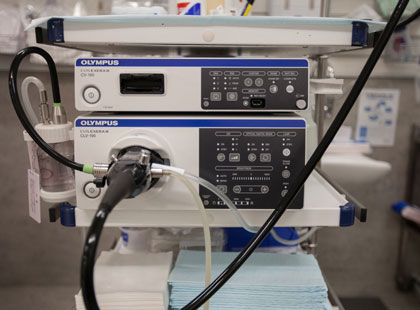Endoscopy

What is endoscopy (gastroscopy)?
This procedure involves an endoscope – a long, thin flexible tube with a ‘video camera’ at the tip – being passed through the mouth into the oesophagus, stomach and first part of the small bowel. It allows the doctor to inspect these areas as well as perform specialised procedures such as biopsies. A gastroscopy is performed as day surgery in hospital.
Why is endoscopy done?
Gastroscopy is usually performed to evaluate symptoms of indigestion, upper abdominal pain, nausea, vomiting or difficulty swallowing. It is also the best test for finding the cause of bleeding from the upper gastrointestinal (GI) tract. Gastroscopy is more accurate than x-rays for detecting inflammation, ulcers or tumours in the upper GI tract. Biopsies (samples of tissue) can be taken to determine sites of infection, to test the functioning of the small bowel and to diagnose abnormal tissue, including conditions such as coeliac disease and cancerous lesions. Gastroscopy is also used to treat conditions of the upper GI tract. Your doctor can pass small instruments through the endoscope to directly treat many abnormalities with little or no discomfort. For example, your doctor might stretch a narrowed area, remove polyps (usually benign growths) or treat bleeding.
How do I prepare for endoscopy?
An empty stomach is essential for a safe and accurate examination, so you should have nothing to eat or drink, including water, for approximately six hours before the examination. Your doctor will provide more specific details about this, depending on the time of day that your test is scheduled. Tell your doctor in advance about any medications you take. You might need to adjust your usual dose for the examination – this is particularly important if you have diabetes. Discuss any allergies to medications, and medical conditions such as heart or lung disease.
How is endoscopy performed?
Before the procedure an anaesthetic (sedative) is given. A small mouthguard may be put between your teeth to stop you from biting the endoscope. If you have false teeth (dentures) they will usually not be removed. The doctor and medical staff monitor your vital signs during the procedure and will attempt to make you as comfortable as possible. The procedure takes about 10-15 minutes. Once sedated and lying in a comfortable position on your left side, the endoscope is passed through the mouth and then in turn through the oesophagus, stomach and duodenum. The tube is just less than one centimetre in diameter and does not enter your windpipe, so it won’t interfere with breathing. A small camera in the end of the scope transmits a video image to a monitor, allowing the doctor to carefully examine the lining of your upper GI tract.
What happens after endoscopy?
You will be monitored in the recovery area until most of the effects of the sedation medication have worn off. You will be able to eat after you leave unless your doctor instructs you otherwise. In most circumstances your doctor will briefly inform you of your test results on the day of the procedure. A follow-up appointment may be made to discuss the test results more fully. The results of any biopsies or samples taken will take several days. Because of the sedation given it is very important that you do not drive a car, travel on public transport alone, operate machinery, sign legal documents or drink alcohol on the same day after the test. It is strongly advised that a friend or relative take you home and stay with you. Full recovery is expected by the next day. Discharge instructions should be carefully read and followed.
